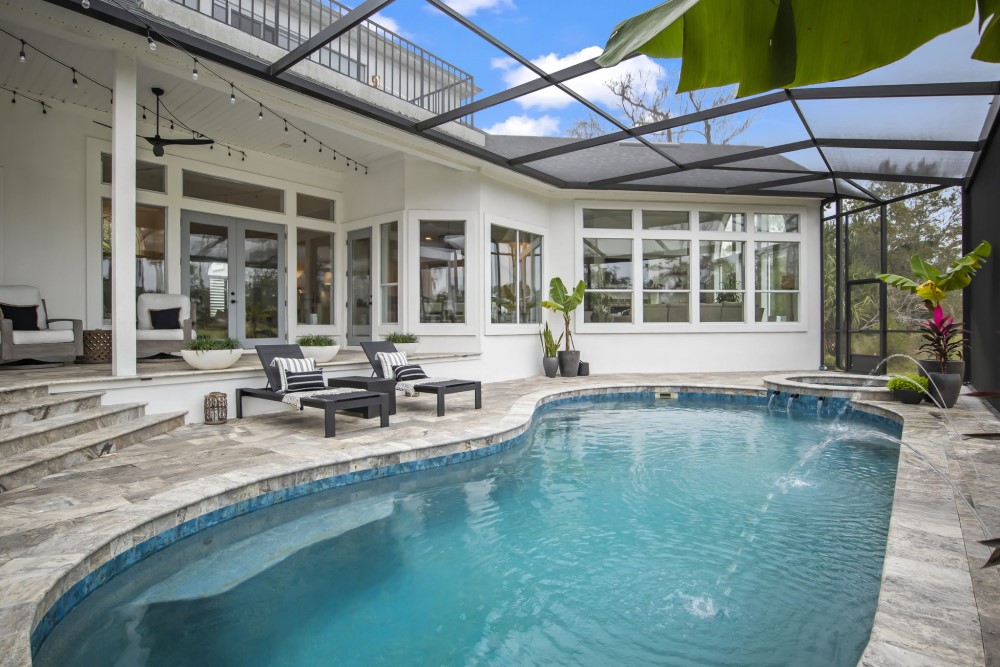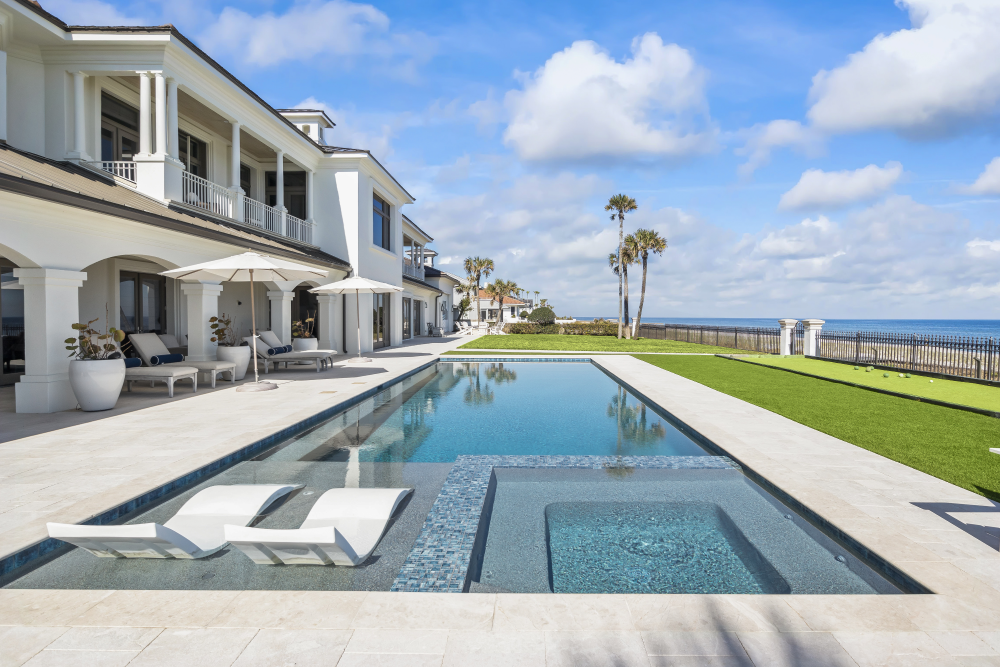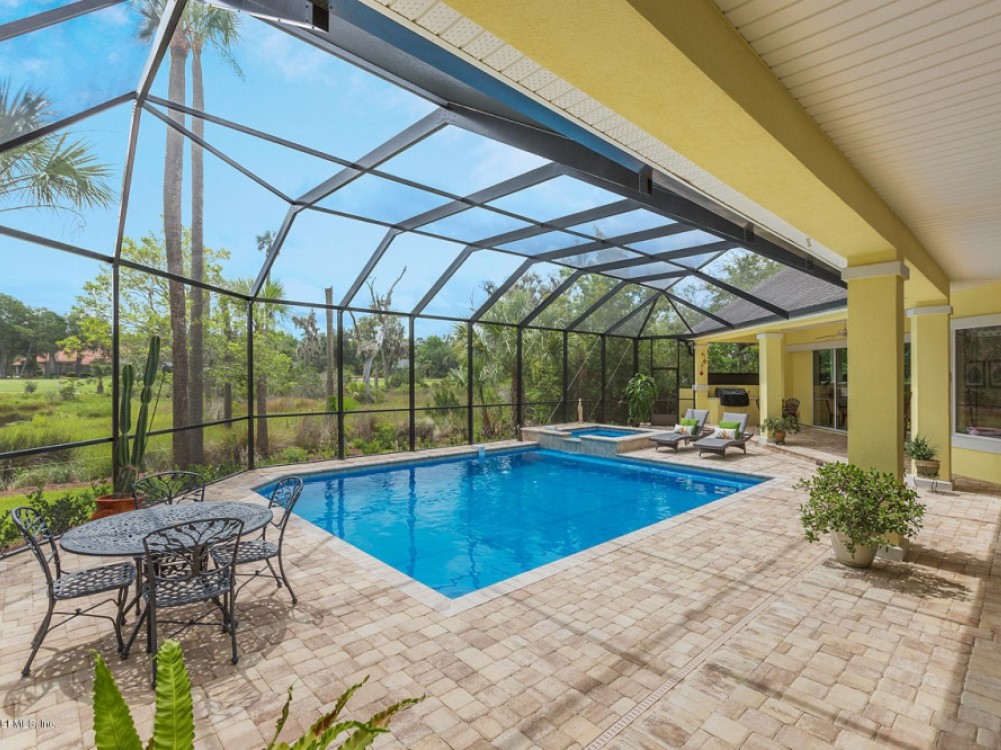Explaining Staining
Imagine a sun-kissed day, the water inviting, and you’re eager to plunge into your backyard pool. The crystal-clear water sparkles under the sunlight, promising a refreshing escape from the heat. However, as you approach the pool, your excitement is dampened by the sight of unsightly stains marring the pool floor and walls. These blemishes not only detract from the aesthetic appeal of your pool but also hint at underlying issues that could affect water quality and the longevity of your pool surfaces.
Stains in your pool can arise from a variety of sources, each leaving its distinct mark. Whether it's the rusty brown spots from iron, the green or blue hues from copper and manganese, or the chalky white deposits from calcium, these stains can be persistent and challenging to remove. Understanding the types of stains and their causes is crucial for effective prevention and treatment. By addressing these issues promptly, you can maintain the pristine condition of your pool, ensuring it remains a beautiful and inviting oasis.
In this comprehensive guide, we’ll delve into the world of pool stains, exploring the different types, their causes, and the best strategies for prevention and removal. From regular maintenance tips to specialized treatments, we’ll provide you with the knowledge and tools needed to keep your pool stain-free. Whether you’re a new pool owner or a seasoned pro, this guide will help you enjoy a spotless, sparkling pool all season long.
Common Types of Pool Stains
Let’s start by introducing the common types of pool stains. Whether you’re a pool owner or a professional in the industry, understanding these stains is essential for effective maintenance and troubleshooting. Here’s a brief overview:
Metal Stains:
Brown Stains: These rusty brown spots are often caused by iron. Iron can leach into the pool water from various sources, such as well water, corroded metal equipment, or even certain types of pool chemicals. When iron is present in the water, it can react with chlorine, forming insoluble iron oxide, commonly known as rust. This rust adheres to pool surfaces, creating unsightly brown stains that can be particularly stubborn to remove. The presence of iron in the water can also be exacerbated by low pH levels, which increase the solubility of iron, making it more likely to precipitate out and stain the pool.
Green or Blue Stains: Copper and manganese are the primary culprits behind these colorful blemishes. Copper stains typically appear green, while manganese stains tend to be blue. Copper can enter the pool through various sources, including algaecides, mineral-based sanitizers, or even from the water supply itself, especially if the water is sourced from wells or areas with high mineral content. When copper oxidizes, it forms compounds that adhere to pool surfaces, resulting in green stains. Manganese, although less common, can also cause staining when it oxidizes, leading to blue or black discolorations. These metals can be particularly challenging to manage because they often require specific treatments to fully remove and prevent recurrence.
To prevent and treat metal stains, it's essential to regularly test your pool water for metal content and use a metal sequestrant if necessary. This chemical binds to metals in the water, preventing them from oxidizing and staining your pool. Additionally, maintaining balanced water chemistry helps minimize the risk of metal stains. If you already have metal stains, there are several approaches to removing them, such as using ascorbic acid for iron stains or specialized metal stain removers for copper and manganese stains. For severe or widespread staining, consulting a pool professional may be the best course of action.
Organic Stains:
Yellow Stains: These yellowish patches are typically caused by organic debris such as leaves, grass, and pollen that find their way into your pool. When this debris settles on the pool floor or walls, it can start to decompose, leading to discoloration. The yellow stains are often more noticeable in areas with poor water circulation. Regular cleaning and skimming are essential to prevent these stains. By promptly removing leaves and other organic matter, you can minimize the risk of yellow stains forming. Additionally, using a pool cover when the pool is not in use can help reduce the amount of debris that enters the water.
Brown or Black Spots: These stains are usually the result of algae growth or decaying organic matter. Algae thrive in warm, sunlit water, especially if the pool’s chlorine levels are low. Brown or black algae can be particularly stubborn, adhering tightly to pool surfaces and creating unsightly spots. To prevent algae-related stains, it’s crucial to maintain proper water circulation and filtration. Regularly brushing the pool walls and floor helps to dislodge any algae that may be starting to form. Additionally, performing regular shock treatments—where a high dose of chlorine is added to the pool—can help kill off any algae spores before they have a chance to grow. Ensuring that your pool’s chlorine levels are consistently maintained within the recommended range is also key to preventing algae growth and the resulting stains.
By understanding the causes of organic stains and implementing these preventive measures, you can keep your pool looking clean and inviting. Regular maintenance and proactive care are essential to managing and preventing these common types of pool stains.
Calcium Stains:
White or Gray Spots: These chalky deposits are a common issue in pools with high calcium levels. When the pool water becomes oversaturated with calcium, it can no longer hold the mineral in solution. As a result, calcium precipitates out and forms scale on pool surfaces, appearing as white or gray spots. This scaling can occur on the pool floor, walls, and even on pool equipment, leading to a rough texture and an unsightly appearance.
Calcium stains are often the result of imbalanced water chemistry, particularly high calcium hardness levels. Factors such as the use of hard water for filling the pool, evaporation, and the addition of calcium-based chemicals can contribute to this issue. To prevent calcium buildup, it's crucial to regularly test and balance your pool water. Maintaining the correct levels of pH, total alkalinity, and calcium hardness is essential. Using a sequestering agent can also help by binding to the calcium in the water, preventing it from precipitating out and forming scale.
In addition to regular water balancing, periodic cleaning of pool surfaces can help manage calcium deposits. For existing calcium stains, specialized scale removers or a diluted acid wash can be effective in removing the buildup. However, it's important to handle these chemicals with care and follow the manufacturer's instructions to avoid damaging the pool surfaces. By staying vigilant with your pool maintenance routine, you can keep calcium stains at bay and ensure your pool remains smooth and inviting.
Rust Stains:
Reddish-Brown Spots: Rust stains are a common issue in pools, characterized by their stubborn reddish-brown appearance. These stains are caused by iron in the water reacting with oxygen, forming iron oxide, commonly known as rust. The iron can enter the pool from various sources, including well water, corroded metal fittings, ladders, or other iron-containing components. Once the iron oxidizes, it adheres to pool surfaces, creating unsightly and persistent stains that can be difficult to remove.
Rust stains often occur near metal fixtures and fittings, such as ladders, screws, and drains, where the iron content is highest. These areas are particularly susceptible to corrosion, especially if the pool water is not properly balanced. Low pH levels can accelerate the corrosion process, increasing the likelihood of rust stains. To prevent these stains, it's essential to regularly inspect and maintain all metal components in and around your pool. Replacing or repairing any corroded parts promptly can help minimize the risk of rust formation.
In addition to regular maintenance, keeping your pool water chemistry balanced is crucial. Ensuring the pH, alkalinity, and chlorine levels are within the recommended ranges can help prevent the oxidation of iron and the formation of rust stains. If rust stains do appear, there are several methods to remove them. Ascorbic acid (vitamin C) is a popular and effective treatment for iron stains. Applying ascorbic acid directly to the stain can help lift the rust, restoring the pool's appearance. For more severe or widespread staining, professional cleaning services may be necessary to achieve the best results. By staying proactive with maintenance and water balance, you can keep rust stains at bay and enjoy a pristine pool.
Scale Stains:
White or Gray Spots: Scale deposits are a common issue in pools, appearing as white or gray spots on tiles, walls, and equipment. These deposits accumulate over time due to mineral buildup, primarily from high levels of calcium, magnesium, and other minerals in the pool water. When the water becomes oversaturated with these minerals, they precipitate out of solution and form hard, chalky deposits on pool surfaces. This scaling not only detracts from the pool's appearance but can also lead to rough textures that are unpleasant to touch and can damage pool equipment.
The primary cause of scale formation is imbalanced water chemistry, particularly high calcium hardness levels. Factors such as the use of hard water for filling the pool, evaporation, and the addition of calcium-based chemicals can contribute to this issue. To prevent scale buildup, it's crucial to regularly test and balance your pool water. Maintaining the correct levels of pH, total alkalinity, and calcium hardness is essential. Using a sequestering agent can also help by binding to the minerals in the water, preventing them from precipitating out and forming scale.
Regular maintenance practices are key to managing scale formation. This includes routine brushing of pool surfaces to dislodge any early deposits before they harden and become more difficult to remove. Additionally, periodic descaling treatments can help dissolve existing scale and prevent new deposits from forming. For severe scaling, more intensive treatments such as acid washing may be necessary, but these should be performed by professionals to avoid damaging the pool surfaces. By staying vigilant with your pool maintenance routine and ensuring balanced water chemistry, you can keep scale stains under control and enjoy a smooth, clean pool.
Remember that identifying the specific type of stain is crucial for effective treatment. Once you know the cause, you can choose the appropriate stain remover or preventive measures. Regular pool maintenance, water testing, and proper chemical balance are essential for keeping your pool stain-free!
Causes of Staining
Understanding the root causes of pool staining is crucial for effective prevention and maintenance. One of the primary causes is unbalanced water chemistry. When the pH, alkalinity, and calcium hardness levels are not within the optimal range, it can lead to various types of stains. For instance, high calcium levels can cause scale deposits, while low pH can increase the solubility of metals, leading to metal stains. Regular testing and balancing of your pool water are essential to prevent these issues.
Another significant cause of staining is debris accumulation. Leaves, twigs, pollen, and other organic materials can settle on the pool floor and walls, leading to organic stains. These materials can decompose and create yellow, brown, or black stains if not promptly removed. Regular skimming and vacuuming of the pool can help prevent debris from accumulating and causing stains.
Algae growth is also a common cause of staining. Algae thrive in warm, sunlit water, especially if the chlorine levels are low. Algae can create green, brown, or black spots on pool surfaces, which can be difficult to remove once established. Maintaining proper water circulation, filtration, and regular shock treatments can help keep your pool algae-free and prevent algae-related stains.
Preventing Stains
To keep your pool pristine and stain-free, follow these practical tips. Regular water testing is essential to monitor chemical levels and make necessary adjustments. This helps maintain balanced water chemistry, preventing conditions that lead to staining. Use a reliable test kit to check pH, alkalinity, calcium hardness, and chlorine levels regularly.
Skimming and vacuuming your pool frequently can prevent organic stains caused by debris accumulation. By promptly removing leaves, twigs, and other debris, you reduce the risk of these materials decomposing and staining your pool surfaces. Additionally, using a pool cover when the pool is not in use can help minimize debris entry.
Algaecide treatment is another effective measure to prevent stains. Algaecides help control and prevent algae growth, which can cause unsightly stains. Regularly adding algaecide to your pool, especially during the warmer months, can keep algae at bay and maintain the clarity and cleanliness of your pool water.
Removing Stains
If stains do appear, there are several methods to remove them, depending on the severity. For mild stains, using specialized stain removers can be effective. These products are formulated to target specific types of stains, such as metal or organic stains. Apply the stain remover according to the manufacturer's instructions and use gentle scrubbing to work on the affected area. A soft brush can help lift the stain without damaging the pool surface.
For severe stains, more intensive measures may be required. Professional cleaning services can provide thorough and effective stain removal. In some cases, it may be necessary to drain the pool and perform treatments such as acid washing to remove stubborn stains. Acid washing involves using a diluted acid solution to clean the pool surfaces, but it should be done by professionals to avoid damaging the pool.
By understanding the causes of staining and implementing these preventive and removal strategies, you can maintain a beautiful, stain-free pool that enhances your outdoor living space and provides a pleasant swimming experience.
Conclusion
Maintaining a stain-free pool requires consistent effort and attention to detail, but the rewards are well worth it. A clean, sparkling pool not only enhances the beauty of your outdoor space but also ensures a safe and enjoyable swimming environment for you and your family. By understanding the different types of stains, their causes, and the best prevention and removal strategies, you can keep your pool looking pristine and inviting all year round.
Regular maintenance is key to preventing stains. This includes balancing your pool's water chemistry, skimming and vacuuming regularly, and using appropriate treatments to prevent algae and mineral buildup. When stains do appear, addressing them promptly with the right products and techniques can prevent them from becoming a bigger problem. Whether it's using specialized stain removers for mild stains or seeking professional help for more severe cases, acting quickly will help maintain your pool's appearance and functionality.
Ready to enjoy a stain-free pool? Coastal Luxury Outdoors is here to help you achieve and maintain the perfect pool. Our team of experts offers personalized advice and top-notch pool care services tailored to your needs. Visit our website to explore more pool maintenance tips and discover how we can assist you in keeping your pool in top condition. Contact us today and take the first step towards a cleaner, more beautiful pool. Let us partner with you in making every swim a pristine and refreshing experience!
Recent Blog Articles

Plaster Options: Pebble vs. Quartz

Choosing the Right Spa Spillway for Your Pool

How Much Does It Cost to Build a Pool in Florida (2025 Price Guide)

The Importance of Annual Filter Replacement


